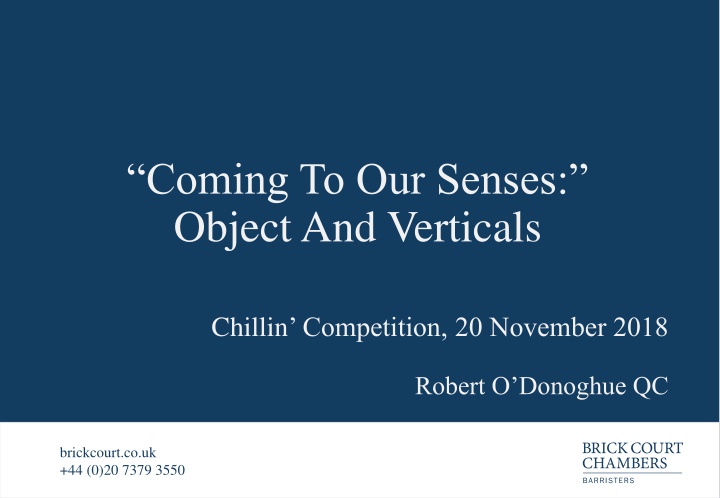
Challenges and Solutions in Competition Law: Object and Vertical Restraints
Explore the complexities of competition law concerning object and verticals restraints, discussing how existing laws may not align with current economic and digital trends. Discover insights into the paradoxical nature of Art.101 cases, the implications of political objectives on market integration, and modest solutions proposed to address these challenges effectively in the digital era.
Download Presentation

Please find below an Image/Link to download the presentation.
The content on the website is provided AS IS for your information and personal use only. It may not be sold, licensed, or shared on other websites without obtaining consent from the author. If you encounter any issues during the download, it is possible that the publisher has removed the file from their server.
You are allowed to download the files provided on this website for personal or commercial use, subject to the condition that they are used lawfully. All files are the property of their respective owners.
The content on the website is provided AS IS for your information and personal use only. It may not be sold, licensed, or shared on other websites without obtaining consent from the author.
E N D
Presentation Transcript
Coming To Our Senses: Object And Verticals Chillin Competition, 20 November 2018 Robert O Donoghue QC brickcourt.co.uk +44 (0)20 7379 3550
Core Thesis The law on object as applied to verticals is: Antediluvian At odds with move to effects analysis At odds with economics Unduly hard to apply for NCAs/courts leading to haphazard application Therefore over-inclusive Minor premise: these issues, if left unresolved, will become acute in digital era
Issues (1) Paradoxical that in era of effects most Art 101 cases are object: object category is growing! Insight that vertical restraints matter when inter- brand competition harmed largely forgotten EU Courts rule in mantra offering no guidance outside easy cases (BIDS, SIA Maxima). National courts can t figure out logic of case law: counterintuitive that the internet ban, adopted with the intention of ensuring that customers purchase correctly fitted clubs should be found to have [anticompetitive] object resulting in the imposition of a quasi-criminal fine (Ping v CMA, para 147)
Issues (2) Dirty secret that object won t be exempted (REIMS II, CECED) airbrushed, leading to false comfort on risks of more object Political objective of market integration contaminates competition law principles Unsatisfactory case law allows NCAs to crusade hard for companies to have EU-wide policies short of low common denominator (overreliance on Block Exemptions for safety) Case law developed in pre-modernisation era leads to law being unmoored post-modernisation
Modest solutions (1) Back to basics: object reserved for cases where harm to competition is a no-brainer ( obvious , plausibly competitive etc.) Economics 101: most verticals restrain intra- brand conduct to improve inter-brand competition so effects needed (Delimitis) Don t forget the quantitative element of object: harm so likely / sufficiently deleterious : capable , potential effect a cop-out absent this quantitative filter (particularly for verticals) object meaningless
Modest solutions (2) Verticals are different to horizontals: ContrastCJEU Maxima para 21 with Allianz Hungaria para 43. E-commerce pointers: Consumers get the Internet; major ecommerce platforms don t need more help Don t forget competition on quality price isn t everything (AEG Telefunken) Recognise greater difficulties of aligning incentives under ecommerce and free-rider problems
Modest solutions (3) E-commerce pointers (cont): Be cautious about treating novel clauses as object and develop experience first plausible efficiency in vertical context should be strong contraindication of object Be honest when applying political objectives (single market) and not applying competition law






















